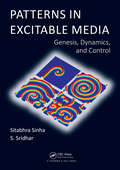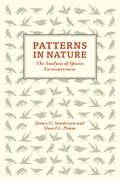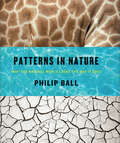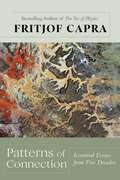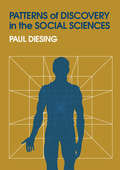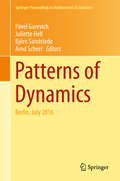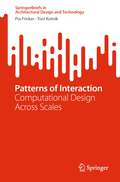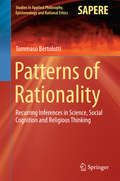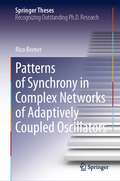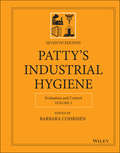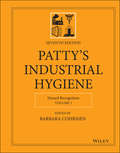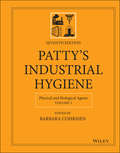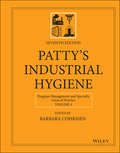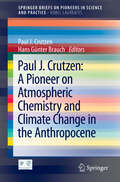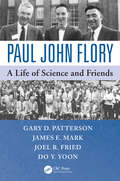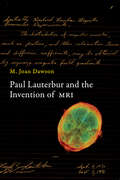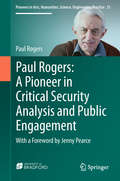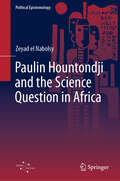- Table View
- List View
Patterns in Excitable Media: Genesis, Dynamics, and Control
by S. Sridhar Sitabhra SinhaExcitable media comprise a class of models for a wide range of physical, chemical, and biological systems that exhibit spontaneous formation of spatial patterns. Patterns in Excitable Media: Genesis, Dynamics, and Control covers recent developments in the interdisciplinary field of dynamics and control of patterns in nonlinear biological systems described by excitable media models. Using examples of many real-life systems, it explores the impact of pattern dynamics on the structural and functional heterogeneities in the system. The book also discusses low-amplitude control schemes for eliminating patterns from an excitable medium, such as life-threatening cardiac arrhythmia. Codes for numerical simulation are provided in the appendix.
Patterns in Nature: The Analysis of Species Co-Occurrences
by James G. Sanderson Stuart L. PimmWhat species occur where, and why, and why some places harbor more species than others are basic questions for ecologists. Some species simply live in different places: fish live underwater; birds do not. Adaptations follow: most fish have gills; birds have lungs. But as Patterns in Nature reveals, not all patterns are so trivial. Travel from island to island and the species change. Travel along any gradient--up a mountain, from forest into desert, from low tide to high tide on a shoreline --and again the species change, sometimes abruptly. What explains the patterns of these distributions? Some patterns might be as random as a coin toss. But as with a coin toss, can ecologists differentiate associations caused by a multiplicity of complex, idiosyncratic factors from those structured by some unidentified but simple mechanisms? Can simple mechanisms that structure communities be inferred from observations of which species associations naturally occur? For decades, community ecologists have debated about whether the patterns are random or show the geographically pervasive effect of competition between species. Bringing this vigorous debate up to date, this book undertakes the identification and interpretation of nature's large-scale patterns of species co-occurrence to offer insight into how nature truly works. Patterns in Nature explains the computing and conceptual advances that allow us to explore these issues. It forces us to reexamine assumptions about species distribution patterns and will be of vital importance to ecologists and conservationists alike.
Patterns in Nature: The Analysis of Species Co-occurrences
by James G. Sanderson Stuart L. PimmWhat species occur where, and why, and why some places harbor more species than others are basic questions for ecologists. Some species simply live in different places: fish live underwater; birds do not. Adaptations follow: most fish have gills; birds have lungs. But as Patterns in Nature reveals, not all patterns are so trivial. Travel from island to island and the species change. Travel along any gradient—up a mountain, from forest into desert, from low tide to high tide on a shoreline —and again the species change, sometimes abruptly. What explains the patterns of these distributions? Some patterns might be as random as a coin toss. But as with a coin toss, can ecologists differentiate associations caused by a multiplicity of complex, idiosyncratic factors from those structured by some unidentified but simple mechanisms? Can simple mechanisms that structure communities be inferred from observations of which species associations naturally occur? For decades, community ecologists have debated about whether the patterns are random or show the geographically pervasive effect of competition between species. Bringing this vigorous debate up to date, this book undertakes the identification and interpretation of nature’s large-scale patterns of species co-occurrence to offer insight into how nature truly works.Patterns in Nature explains the computing and conceptual advances that allow us to explore these issues. It forces us to reexamine assumptions about species distribution patterns and will be of vital importance to ecologists and conservationists alike.
Patterns in Nature: Why the Natural World Looks the Way It Does
by Philip BallThe acclaimed science writer &“curates a visually striking, riotously colorful photographic display…of physical patterns in the natural world&” (Publishers Weekly, starred review). Though at first glance the natural world may appear overwhelming in its diversity and complexity, there are regularities running through it, from the hexagons of a honeycomb to the spirals of a seashell and the branching veins of a leaf. Revealing the order at the foundation of the seemingly chaotic natural world, Patterns in Nature explores not only the math and science but also the beauty and artistry behind nature&’s awe-inspiring designs. Unlike the patterns we create, natural patterns are formed spontaneously from the forces that act in the physical world. Very often the same types of pattern and form—such as spirals, stripes, branches, and fractals—recur in places that seem to have nothing in common, as when the markings of a zebra mimic the ripples in windblown sand. But many of these patterns can be described using the same mathematical and physical principles, giving a surprising unity to the kaleidoscope of the natural world. Richly illustrated with 250 color photographs and anchored by accessible and insightful chapters by esteemed science writer Philip Ball, Patterns in Nature reveals the organization at work in vast and ancient forests, powerful rivers, massing clouds, and coastlines carved out by the sea. By exploring similarities such as the branches of a tree and those of a river network, this spectacular visual tour conveys the wonder, beauty, and richness of natural pattern formation.
Patterns of Connection: Essential Essays from Five Decades
by Fritjof CapraWinner of the Silver Medal for Environment/Ecology in the 2022 Independent Publisher (IPPY) Book AwardsFritjof Capra, scientist, educator, activist, and accomplished author, presents the evolution of his thought over five decades in Patterns of Connection. First introduced in the late 1950s to the work of Werner Heisenberg, a founder of quantum mechanics, Capra quickly intuited the connections between the discoveries of quantum physics and the traditions of Eastern philosophy—resulting in his first book, the bestselling The Tao of Physics. This synthesis, representative of the change from the mechanistic worldview of Descartes and Newton to a systemic, ecological one, went on to inform Capra&’s thinking about the life sciences, ecology, and environmental policy. His observations of sustainable communities in nature inspired his work on systems theory—the complex web of interrelated processes that organize everything from biological systems to social, cultural, and political systems.Today Fritjof Capra remains a major figure at the crossroads of physics, spirituality, environmentalism, and systems theory. Organized thematically and chronologically, the essays in Patterns of Connection document the revolutionary and far-reaching intellectual journey of one of the major public thinkers of the last half-century.
Patterns of Discovery in the Social Sciences
by Paul DiesingSocial scientists are often vexed because their work does not satisfy the criteria of "scientific" methodology developed by philosophers of science and logicians who use the natural sciences as their model. In this study, Paul Diesing defines science not by reference to these arbitrary norms delineated by those outside the field but in terms of norms implicit in what social scientists actually do in their everyday work.
Patterns of Dynamics: Berlin, July 2016 (Springer Proceedings in Mathematics & Statistics #205)
by Pavel Gurevich Juliette Hell Björn Sandstede Arnd ScheelTheoretical advances in dynamical-systems theory and their applications to pattern-forming processes in the sciences and engineering are discussed in this volume that resulted from the conference Patterns in Dynamics held in honor of Bernold Fiedler, in Berlin, July 25-29, 2016.The contributions build and develop mathematical techniques, and use mathematical approaches for prediction and control of complex systems. The underlying mathematical theories help extract structures from experimental observations and, conversely, shed light on the formation, dynamics, and control of spatio-temporal patterns in applications. Theoretical areas covered include geometric analysis, spatial dynamics, spectral theory, traveling-wave theory, and topological data analysis; also discussed are their applications to chemotaxis, self-organization at interfaces, neuroscience, and transport processes.
Patterns of Earth and Sky: Analyzing Stars on Ancient Artifacts, Investigation Notebook
by The Lawrence Hall of ScienceNIMAC-sourced textbook
Patterns of Interaction: Computational Design Across Scales (SpringerBriefs in Architectural Design and Technology)
by Pia Fricker Toni KotnikThis book is a reflection on contemporary computational design thinking at the intersection of architecture, urban design, and landscape architecture, in a time marked by complex challenges like climate change, urbanization and population growth. Based on a critical rethinking of the notion of ground and the relation between the manmade and the natural environment, an understanding of architecture as regenerative practice is proposed. It aims at a built environment as landscape, at an architecture of prosthetic nature. The design approach is illustrated by a number of design experiments conducted within a studio setting and complemented by a series of conversations with leading experts on sustainable design and landscape architecture.
Patterns of Life
by Smithsonian InstitutionPatterns of Life is part of the Smithsonian Science Stories™ Literacy Series and has on-grade and below-grade leveled readers available to accommodate a range of readers in an elementary classroom. The line and dot graphic at the bottom of the front cover indicates the reading level. When the dot is at the top of the line, the reading level for the book is on-grade. When it is at the bottom, the book is below-grade. You can also find the official Lexile Scores for each reading in the Table of Contents. The books in this literacy series enhance and reinforce the science concepts taught in the Smithsonian Science for the Classroom™ curriculum.
Patterns of Rationality
by Tommaso BertolottiThis book proposes an applied epistemological framework for investigating science, social cognition and religious thinking based on inferential patterns that recur in the different domains. It presents human rationality as a tool that allows us to make sense of our (physical or social) surroundings. It shows that the resulting cognitive activity produces a broad spectrum of outputs, such as scientific models and experimentation, gossip and social networks, but also ancient and contemporary deities. The book consists of three parts, the first of which addresses scientific modeling and experimentation, and their application to the analysis of scientific rationality. Thus, this part continues the tradition of eco-cognitive epistemology and abduction studies. The second part deals with the relationship between social cognition and cognitive niche construction, i. e. the evolutionarily relevant externalization of knowledge onto the environment, while the third part focuses on what is commonly defined as "irrational", thus being in a way dialectically opposed to the first part. Here, the author demonstrates that the "irrational" can be analyzed by applying the same epistemological approach used to study scientific rationality and social cognition; also in this case, we see the emergence of patterns of rationality that regulate the relationships between agents and their environment. All in all, the book offers a coherent and unitary account of human rationality, providing a basis for new conceptual connections and theoretical speculations.
Patterns of Synchrony in Complex Networks of Adaptively Coupled Oscillators (Springer Theses)
by Rico BernerThe focus of this thesis is the interplay of synchrony and adaptivity in complex networks. Synchronization is a ubiquitous phenomenon observed in different contexts in physics, chemistry, biology, neuroscience, medicine, socioeconomic systems, and engineering. Most prominently, synchronization takes place in the brain, where it is associated with cognitive capacities like learning and memory, but is also a characteristic of neurological diseases like Parkinson and epilepsy. Adaptivity is common in many networks in nature and technology, where the connectivity changes in time, i.e., the strength of the coupling is continuously adjusted depending upon the dynamic state of the system, for instance synaptic neuronal plasticity in the brain. This research contributes to a fundamental understanding of various synchronization patterns, including hierarchical multifrequency clusters, chimeras and other partial synchronization states. After a concise survey of the fundamentals of adaptive and complex dynamical networks and synaptic plasticity, in the first part of the thesis the existence and stability of cluster synchronization in globally coupled adaptive networks is discussed for simple paradigmatic phase oscillators as well as for a more realistic neuronal oscillator model with spike-timing dependent plasticity. In the second part of the thesis the interplay of adaptivity and connectivity is investigated for more complex network structures like nonlocally coupled rings, random networks, and multilayer systems. Besides presenting a plethora of novel, sometimes intriguing patterns of synchrony, the thesis makes a number of pioneering methodological advances, where rigorous mathematical proofs are given in the Appendices. These results are of interest not only from a fundamental point of view, but also with respect to challenging applications in neuroscience and technological systems.
Patty's Industrial Hygiene, Evaluation and Control: 4 Volume Set
by Barbara CohrssenSince the first edition in 1948, Patty’s Industrial Hygiene and Toxicology has become a flagship publication for Wiley. During its nearly seven decades in print, it has become a standard reference for the fields of occupational health and toxicology. The volumes on industrial hygiene are cornerstone reference works for not only industrial hygienists but also chemists, engineers, toxicologists, lawyers, and occupational safety personnel. Volume 3 covers Recognition and Evaluation of Physical Agents and Biohazards. All of the chapters have been updated and a new chapter on Robotics has been added. These subjects are increasing in importance to industrial hygienists.
Patty's Industrial Hygiene, Hazard Recognition: 4 Volume Set
by Barbara CohrssenSince the first edition in 1948, Patty’s Industrial Hygiene and Toxicology has become a flagship publication for Wiley. During its nearly seven decades in print, it has become a standard reference for the fields of occupational health and toxicology. The volumes on industrial hygiene are cornerstone reference works for not only industrial hygienists but also chemists, engineers, toxicologists, lawyers, and occupational safety personnel. Volume 1 covers Introduction of Industrial Hygiene and Recognition of Chemical Agents. In addition to revised and updated chapters, a number of new chapters reflect current technology and concerns. The chapters include Ethics in Industrial Hygiene, Prevention through Design, Risk Communication, Managing Workplace Demographics, and Mastering Digital Media for Workers, Employers and Community Practice.
Patty's Industrial Hygiene, Physical and Biological Agents: 4 Volume Set
by Barbara CohrssenSince the first edition in 1948, Patty’s Industrial Hygiene and Toxicology has become a flagship publication for Wiley. During its nearly seven decades in print, it has become a standard reference for the fields of occupational health and toxicology. The volumes on industrial hygiene are cornerstone reference works for not only industrial hygienists but also chemists, engineers, toxicologists, lawyers, and occupational safety personnel. Volume 3 covers Recognition and Evaluation of Physical Agents and Biohazards. All of the chapters have been updated and a new chapter on Robotics has been added. These subjects are increasing in importance to industrial hygienists.
Patty's Industrial Hygiene, Program Management and Specialty Areas of Practice
by Barbara CohrssenSince the first edition in 1948, Patty’s Industrial Hygiene and Toxicology has become a flagship publication for Wiley. During its nearly seven decades in print, it has become a standard reference for the fields of occupational health and toxicology. The volumes on industrial hygiene are cornerstone reference works for not only industrial hygienists but also chemists, engineers, toxicologists, lawyers, and occupational safety personnel. Volume 4 covers environmental and health and safety program management, with a number of new chapters on sustainability, construction health and safety, health and safety of new energies and working with cannabis.
Paul J. Crutzen: A Pioneer on Atmospheric Chemistry and Climate Change in the Anthropocene
by Hans Günter Brauch Paul J. CrutzenThis book contains texts by the Nobel laureate Paul J. Crutzen who is best known for his research on ozone depletion. It comprises Crutzen's autobiography, several pictures documenting important stages of his life, and his most important scientific publications. The Dutch atmospheric chemist is one of the world's most cited scientists in geosciences. His political engagement makes him a tireless ambassador for environmental issues such as climate change. He popularized the term 'Anthropocene' for the current geological era acknowledging the enduring influence of humankind on planet Earth. This concept conceives humans to be a geologic factor, influencing the evolution of our globe and the living beings populating it. The selection of texts is representing Paul Crutzen´s scientific oeuvre as his research interests span from ozone depletion to the climatic impacts of biomass burning, the consequences of a worldwide atomic war - the Nuclear Winter - to geoengineering and the Anthropocene.
Paul J. Crutzen: A Pioneer on Atmospheric Chemistry and Climate Change in the Anthropocene (SpringerBriefs on Pioneers in Science and Practice #50)
by Hans Günter Brauch Paul J. CrutzenThis book contains texts by the Nobel laureate Paul J. Crutzen who is best known for his research on ozone depletion. It comprises Crutzen’s autobiography, several pictures documenting important stages of his life, and his most important scientific publications. The Dutch atmospheric chemist is one of the world’s most cited scientists in geosciences. His political engagement makes him a tireless ambassador for environmental issues such as climate change. He popularized the term ‘Anthropocene’ for the current geological era acknowledging the enduring influence of humankind on planet Earth. This concept conceives humans to be a geologic factor, influencing the evolution of our globe and the living beings populating it. The selection of texts is representing Paul Crutzen´s scientific oeuvre as his research interests span from ozone depletion to the climatic impacts of biomass burning, the consequences of a worldwide atomic war – the Nuclear Winter - to geoengineering and the Anthropocene.
Paul John Flory: A Life of Science and Friends
by Gary D. Patterson James E. Mark Joel Fried Do YoonPaul John Flory: A Life of Science and Friends is the first full-length treatment of the life and work of Paul John Flory, recipient of the Nobel Prize in chemistry in 1974. It presents a chronological progression of his scientific, professional, and personal achievements as recounted and written by his former students and colleagues.This book cove
Paul Lauterbur and the Invention of MRI
by M. Joan DawsonThe story behind the invention of the most important medical diagnostic tool since the X-ray.On September 2, 1971, the chemist Paul Lauterbur had an idea that would change the practice of medical research. Considering recent research findings about the use of nuclear magnetic resonance (NMR) signals to detect tumors in tissue samples, Lauterbur realized that the information from NMR signals could be recovered in the form of images—and thus obtained noninvasively from a living subject. It was an unexpected epiphany: he was eating a hamburger at the time. Lauterbur rushed out to buy a notebook in which to work out his idea; he completed his notes a few days later. He had discovered the basic method used in all MRI scanners around the world, and for this discovery he would share the Nobel Prize for Physiology or Medicine in 2003. This book, by Lauterbur's wife and scientific partner, M. Joan Dawson, is the story of Paul Lauterbur's discovery and the subsequent development of the most important medical diagnostic tool since the X-ray.With MRI, Lauterbur had discovered an entirely new principle of imaging. Dawson explains the science behind the discovery and describes Lauterbur's development of the idea, his steadfastness in the face of widespread skepticism and criticism, and related work by other scientists including Peter Mansfield (Lauterbur's Nobel co-recipient), and Raymond Damadian (who famously feuded with Lauterbur over credit for the ideas behind MRI). She offers not only the story of one man's passion for his work but also a case study of how science is actually done: a flash of insight followed by years of painstaking work.
Paul Rogers: With a Foreword by Jenny Pearce (Pioneers in Arts, Humanities, Science, Engineering, Practice #21)
by Paul RogersThis book brings together a collection of writings over the past half century from Professor Paul Rogers. As a leading peace researcher he has gained an international reputation for the critical, independent and rigorous analysis of international security and the underlying causes of global conflict. His work on the responses to 9/11 and the continuing failure of the war on terror, in particular, has shown prescience that has attracted widespread attention. Moreover, he has coupled his academic analysis with a determination to communicate widely beyond the university environment. With many thousands of radio and television interviews, hundreds of public lectures and a world-wide following for his web publishing, this extramural engagement consistently seeks to raise the level of public debate on international security issues.- Provides a radically different perspective on global security, based on 50 years of analysis- Uniquely integrates economic, environmental and security analysis into a single overview- Cogently demonstrates the urgent need to rethink our entire approach to global security
Paulin Hountondji and the Science Question in Africa (Political Epistemology)
by Zeyad el NabolsyThis book offers a systematic reconstruction of Paulin Hountondji&’s contributions to the debate about the place of modern science on the African continent. The book shows that Hountondji develops an account of modern science that is sociologically sensitive to the entanglement between modern science and colonialism on the African continent without falling into epistemic relativism about the claims of modern science. It is argued that Hountondji&’s views on modern science express a strong historical materialist influence, and that he develops a theory of science that draws both on the Hessen-Grossmann hypothesis and dependency theory. Thus, this book brings together two strands of historical materialist thought about science that have hitherto been isolated from one another. This book is of interest to scholars who specialize in African philosophy, history and philosophy of science, global philosophy, and African studies.
Paulo's Parachute Mission
by Engineering is Elementary TeamPaulo is not happy about his family's move to Alcantara, Brazil to be close to its space launch pad. <P><P>While Paulo's parents, both aerospace engineers, are excited about the design projects in their new jobs, Paulo is worried about leaving his friends behind and meeting new people. The last thing he wants to do is make friends with his new neighbor, Lucas.
